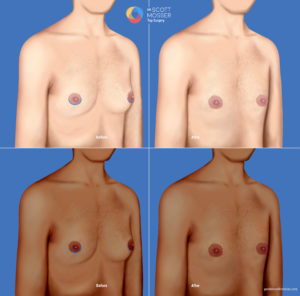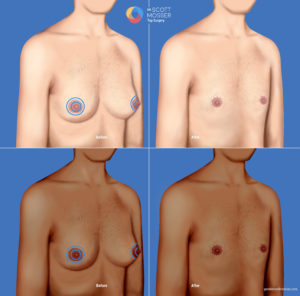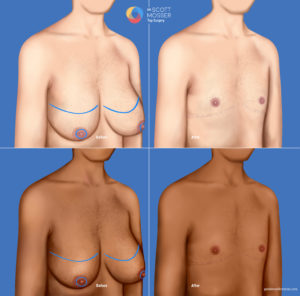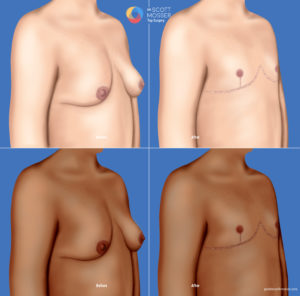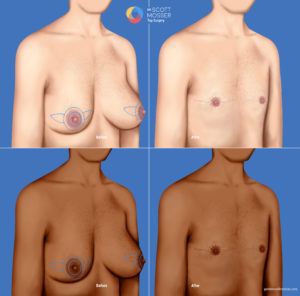Types of Top Surgery
There are different techniques and incision options available for chest reconstruction top surgery, formerly FTM top surgery, each with its unique benefits and risks. In this article, we will explore the various incision options based on your goals, size of your chest, and skin elasticity. Incision options include liposuction, fishmouth, periareolar/circumareolar, double incision, inverted T (anchor), buttonhole, and keyhole top surgery. Additionally, we will also discuss nipple and areola appearance and scarring, which may vary depending on the procedure chosen.
Chest Reconstruction Top Surgery Procedure Options
Many surgical procedures fall within the category of chest reconstruction and breast reduction top surgery. This includes the most common double incision procedure, as well as minimal scar techniques such as the keyhole or periareolar incision. There are different skin excision procedures and procedures which may preserve the nerve supply to the nipples, such as inverted T, buttonhole, lollipop, and fishmouth. Each of these procedures come with both benefits and risks to consider, so a thorough discussion with a surgeon regarding the procedures they offer is often the best way to match your desires, priorities, and anatomy with the best procedure for you. By removing unwanted chest tissue, chest reconstruction top surgery allows patients to feel more comfortable with their bodies by better aligning physical characteristics with an internal sense of self and the self they want to present to the world.
Incision Choices
When it comes to incision location, there are several possible options that will be discussed in-depth during your consultation. The incisions used during your surgery will depend on the size of your chest and its level of elasticity or firmness.
Incision options include the following:
Liposuction incision
Liposuction may rarely be performed alone (if you have a very small chest and no skin sagging), or more commonly be done in combination with other incision patterns to remove excess tissue. Liposuction requires a very small incision (about 4mm) to access underlying tissue. Most patients require more extensive tissue removal to achieve desired results.
Keyhole incision
A keyhole incision is ideal for patients with small chests and high skin elasticity. During this technique, a small incision is made under or across the lower border of the areola (the pigmented skin around the nipple). A keyhole incision can remove underlying tissue, but it cannot address excess skin.
Circumareolar/periareolar incision
A periareolar incision is ideal for patients with moderate chest tissue and appropriate skin elasticity. A circular incision is made all the way around the edge of the areola to remove chest tissue. A slightly larger ring incision is then made to remove excess skin. The skin is pulled taut toward the center and the nipple is reattached. This effect mimics the act of pulling a drawstring bag closed. Another vertical incision that extends below the areola may also be necessary to target and remove additional excess skin.
Double incision
A double incision approach is usually needed for patients with large chests, or chests that sag quite a bit. A horizontal or U-shaped incision is made on the lower border of the pectoral (chest) muscle. The skin is peeled back so that chests and fatty tissue can be removed. Another incision is then made to remove the nipple. Each nipple is resized, if necessary, and then replaced as a free nipple graft. If your chest is shaped such that your nipple position is lower than the fold beneath the chest, then you will likely require the double incision or an inverted T (anchor) incision type.
Inverted T (anchor) & Buttonhole incision
An inverted T (anchor) incision pattern is also an option for patients with larger chests with extra skin. This procedure keeps the nipple and areola attached to the nerves and other tissue , avoiding the need for a free nipple graft. Though the surgeon has good control over chest volume, there is a good chance that nipple sensation will be significantly diminished or need to recover from being numb. Advantages include avoiding the free nipple graft (and therefore a lower risk of complete nipple loss) and having a nipple and areola that is more full in appearance. A disadvantage is the presence of an additional vertical incision, and it cannot achieve the same level of flatness as with the double incision approach (because of the tissue left behind to supply blood to the nipple area).
A nearly identical procedure, with similar advantages and disadvantages, is the buttonhole incisions. The primary difference between buttonhole and inverted T incisions is that buttonhole does not require a vertical incision because it is performed on patients who have less chest tissue and skin to remove.
Fishmouth incision
This approach produces incision contours that are higher on the chest, and therefore more consistent with the border of the chest muscle. However, it requires the final areola position to be in line with the scar, which is not a natural proportion between the areola and the shadow of the muscle, which this scar is trying to mimic. Because of this, fishmouth incision is infrequently used.
Other Incision Types
Less common incision types include the lollipop incision, which is similar to the periareolar incision but with a vertical incision extending down from the areola, and the two-stage periareolar incision in which the first stage is a keyhole approach to remove all chest tissue and see how the skin responds, to make sure that a periareolar surgery is acceptable for the 2nd stage (versus needing to remove more tissue with a double incision-type approach, for example). A two-stage procedure is not done frequently, as most patients only want to undergo one surgery to achieve their desired final outcome.
Nipple and Areola Appearance
The goal is to make your nipples look as natural as possible following surgery. In some cases, a nipple graft may be necessary to achieve this goal. A nipple graft involves detaching, resizing, and relocating the nipple-areolar complex to appear more masculine. It is possible (though unlikely) for nipple grafts to be lost due to tissue death. In this case, patients can pursue medical tattooing to correct the apperance of or create a replacement nipple and areola, if desired.
There is a small chance that you will be unhappy with the placement or position of your nipples. It will take several months before the final results of your procedure are visible. If after sufficient healing time you are still unhappy with the appearance of your nipples, a revision surgery can be performed.
Post-Surgical Scarring
It is important to have realistic expectations before undergoing sur
gery. Our surgeons will make every effort to make your scarring as minimal as possible, though you will have at least some permanent scarring following chest reconstruction top surgery.
Your level of scarring will depend on the type of procedure along with how your skin heals and scars. Additionally, people who smoke may experience slower than normal healing which may cause scars to worsen. It is recommended that all patients quit smoking in advance of surgery.
Following surgery, you will be provided with specific instructions on how to minimize the appearance of scarring. Your scars will appear dark and bumpy for the first few months after surgery. However, over the course of 12-18 months, they will gradually fade, flatten and become less noticeable.
Additional aesthetic considerations
In the following video, Dr. Jacobs (he/him) explains his approach to addressing patient concerns around chest hollowness and nipple appearance after top surgery. If you have any other questions or concerns about your top surgery goals, you can request to speak with any of our surgeons in a free, virtual or in-person consultation.
Request a Free Surgical Consultation Today.
All virtual and in-person consultations with our board-certified surgeons are free. Once you fill out this form, our patient care team will reach out and guide you through every step to get to surgery.


